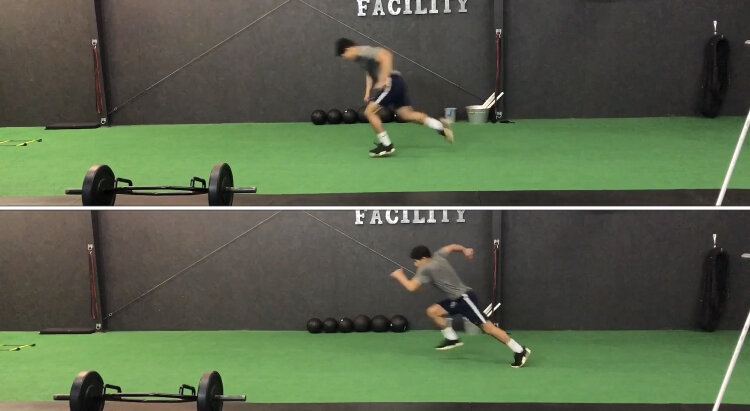There's Benefits To A "False Step"?! | Sports Performance | The FIT Facility
There’s Benefits To A False Step?!
The false step has been viewed as the anti-athlete’s method of movement by sports coaches for decades. But why? To be perfectly honest, probably for two reasons: it looks like the athlete “steps backwards” to go forward, and the coach doesn’t have understanding of biomechanics.
Now if you happen to be the dinosaur sports coach that immediately responses “it doesn’t take a genius to see that the athlete is stepping backwards first, to go forward”, I’d rebute, “it doesn’t take a genius to see that one is actually much faster!”
Faster? Yes, FASTER!
Multiple studies prove this too!
For example, this 2001 study shows that 95% of the time, the athletes intrinsically chose the plyo-step, which allowed them to put MORE FORCE AND POWER IN THE GROUND, than the forward start.
Another study from 2014 compared starting positions of Division 1 collegiate linebackers sprint 5 meters. They started from sprinting blocks (those found in track and field), a parallel stance (no plyo-step) and a parallel stance (with plyo-step, “rhythm step”). The start from the blocks was the quickest (no surprise, this is why they’re used in track and field). However, for field and court sport athletes, this is useless.
The plyo-step was shown to out perform the forward step from a parallel stance in both 2.5m and 5m!
And even more recently, in a 2019 study, 30 collegiate aged student athletes were chosen to sprint for 10 meters from both a parallel stance forward step only and from a parallel stance with a plyo-step. The results? The plyo-step was significantly faster.
How much?
.23 seconds faster. So almost a quarter of a second!
The difference could mean a broken arm tackle that breaks for a first down because the ball carrier was just a tad too far away, OR a tackle for a loss on 3rd and long!
What Exactly Is A Step?
So before we dive into the details, let’s first define our terms.
What exactly is a step?
In this example, we will use an athlete walking forward. As we would all assume, a step is when one athletes put a foot in front of the other and begins to: walk, jog and/or run. We’ve known this since we took our first steps. However, it is important to note that a “step” is when an athlete begins to travel in an intended/or unintended direction, which involves propulsion of their center of mass (hips).
So, did the athlete’s hips move in the intended/unintended direction of travel? Or did just the feet reposition? These are the critical aspects that will either determine a true “false step” or “plyo-step”.
What Is A False Step?
If a step is when an athlete moves their center of mass in any direction, then an actual “false step” is something that athletes SHOULD avoid. Let’s clarify. As stated earlier, actual “step” would involve an athlete moving their center of mass in a specific direction (their hips). Without this movement of center of mass, it’s not actual a step.
So for example, if a middle linebacker at the snap of the ball begins to read an inside zone, and his first “step” is backwards (his center of mass actually shifted backwards), then this of course IS wasted movement. This is a “false step”!
What Is A Plyo-Step?
Then what’s a plyo-step?
A plyo-step, or “repositioning step” is simply when the athlete “repositions” their foot behind their center of mass. So, no “step” was actually taken.
This happens incredibly fast.
Many times, this happens without the athlete even knowing. It’s our nervous system making an effort to get to the desired location in the quickest amount of time possible.
The plyo-step utilizes the body’s stretch shorten cycle (a quick loading/unloading of the muscles and tendons that release stored energy in the body, to aid in propulsion, very much like a spring). This action, along with the new sprint angles the athlete just created helps to make an athlete quicker out of the gate!
Let’s get back to our linebacker example. If the linebacker makes the same read and his feet shift from a lateral (parallel stance) to a quick plyo-step (foot shifts back, CENTER OF MASS NEVER CHANGES, athletes uses stretch reflex to propel themselves forward), then this isn’t a waste of movement, and has been shown to actually be faster.
Breakdown of video below!
Both videos start from a parallel stance, the video on top, the athlete repositions his foot behind him to utilize the stretch shorten cycle and also create better angles for acceleration. Notice, his center of mass (hips) never move backwards, only his foot.
Here, the still was taken on the athletes first step on the bottom video. That same athlete is already transitioning between his 2/3 step in the top!
Last still. The video on the bottom, the athlete final gets to his 2nd step, while the same athlete on the top (plyo-step) is now continuing to accelerate through his 3/4th!
The series of stills from the previous video, are all part of the complete speed and agility program we offer here at The FIT Facility in Florence, AL. To learn more about our complete Sports Performance program offered here at The FIT Facility, click here.
Or if you’re ready to start training and improve your speed and agility, click here and fill out a request!
Sources
https://www.tandfonline.com/doi/figure/10.1080/14763141.2020.1713205?scroll=top&needAccess=true
https://www.youtube.com/watch?v=OY5afH58uHA
https://www.youtube.com/watch?v=0hfpGZHsSLc
https://en.wikipedia.org/wiki/Stretch_shortening_cycle
https://www.ncbi.nlm.nih.gov/pubmed/11165285
https://www.ncbi.nlm.nih.gov/pubmed/24626141



